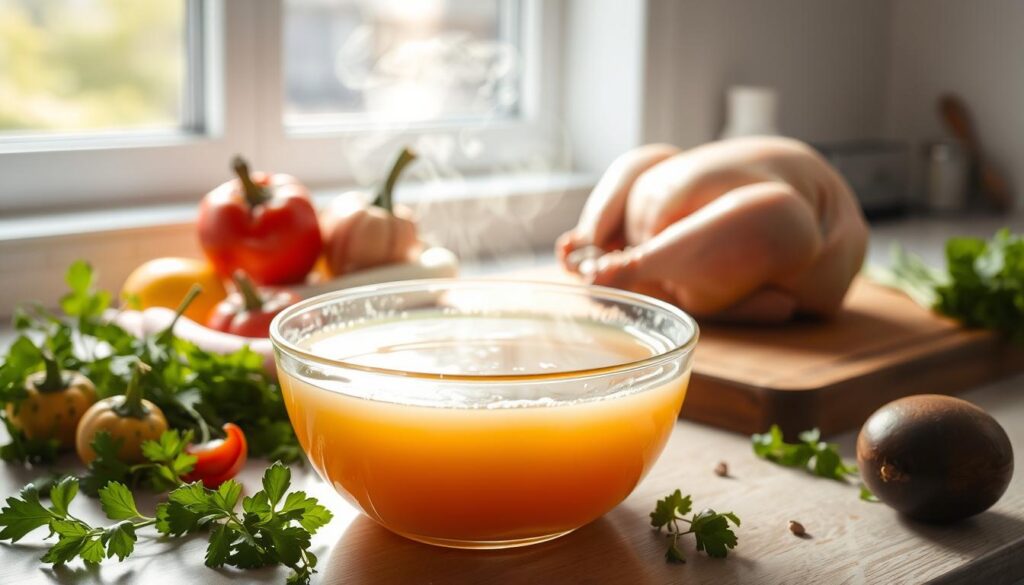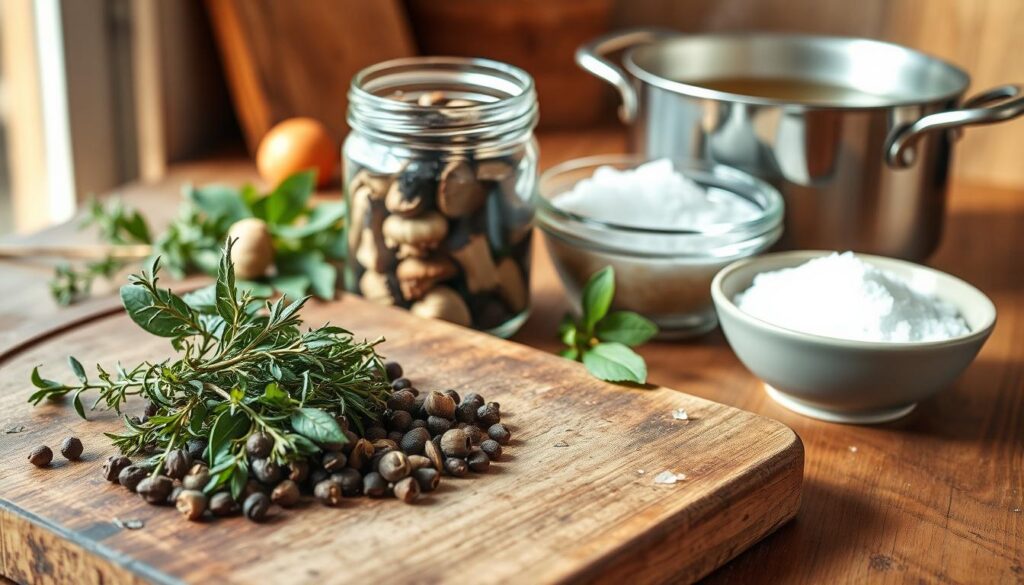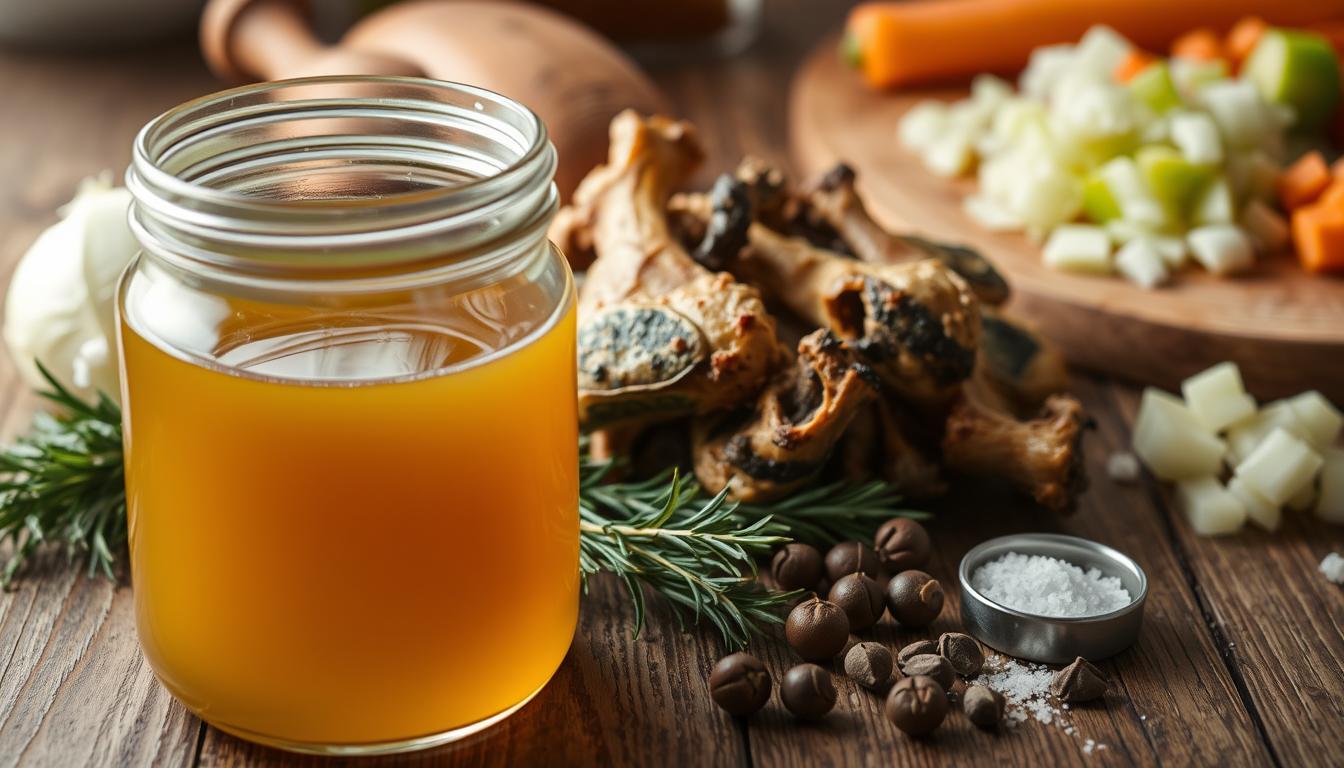Easy Chicken Bouillon Recipe You Can Make at Home
Table of Contents
Easy Chicken Bouillon Recipe You Can Make at Home
Ever opened a store-bought broth and wished it had more depth? A rich, savory flavor that turns simple dishes into something extraordinary? You’re not alone. Many home cooks crave that restaurant-quality taste without artificial additives or excess salt.
The secret lies in homemade chicken bouillon. Unlike pre-packaged versions, this blend lets you control every ingredient—keeping it gluten-free, keto-friendly, or vegan. Nutritional yeast adds a umami punch, while herbs and spices create layers of flavor in just 5 minutes.
Imagine enhancing soups, stews, or even rice with a spoonful of this golden powder. It’s a pantry hero with a shelf life of up to a year. No more last-minute grocery runs for broth cubes!
Key Takeaways
- Healthier than store-bought options: sugar-free, low-carb, and customizable.
- Uses nutritional yeast for a rich, chicken-like flavor without meat.
- Ready in 5 minutes with common pantry staples.
- Lasts 6–12 months, perfect for meal prep.
- Versatile: replaces broth, bouillon cubes, or seasoning blends.
Why Make Homemade Chicken Bouillon?
Commercial broth can be loaded with additives you don’t want in your meals. From MSG to excessive salt, store-bought options often sacrifice quality for shelf life. With homemade bouillon, you skip the preservatives and anti-caking agents—just pure, customizable flavor.

Take control of your sodium intake. Many pre-packaged broths contain 30% more salt than recommended. DIY versions let you adjust levels for dietary needs, whether keto, low-carb, or heart-healthy.
Flavor is another win. Blend nutritional yeast for umami richness or tweak herbs like rosemary and thyme. One user raved: “My kids devour soups made with this—no more picky eaters!”
Moreover, freeze-dried homemade blends last years, unlike liquid broth that spoils in days. Imagine grabbing a spoonful to elevate tacos or grains anytime. It’s cost-effective too—pantry staples cost pennies per serving.
- Healthier: No hidden additives or excess salt.
- Adaptable: Swap spices for vegan or spicy twists.
- Long-lasting: Stays fresh for months in airtight jars.
Essential Ingredients for Chicken Bouillon
Transform basic meals with powerhouse ingredients that pack flavor and nutrition. The magic lies in balancing umami-rich bases, aromatic herbs, and precise seasoning. Here’s what you’ll need:

Nutritional Yeast: The Flavor Base
Nutritional yeast is the secret to a rich, savory taste. Packed with B vitamins and protein, it adds depth without meat. Use 2 cups for a bold umami punch.
Herbs and Spices
Layer flavors with these essentials:
- Rosemary and thyme for earthy notes
- Garlic and onion powder (1/4 cup each) for warmth
- Optional cayenne for a spicy kick
Salt and Pepper Ratios
Balance is key. Use 1/3 cup fine-grain sea salt for even distribution. For low-sodium versions, reduce to 1/4 cup. A dash of black pepper enhances without overpowering.
Pro tip: Grind spices fresh for maximum aroma.
How to Make Chicken Bouillon Powder
Skip the store-bought versions and create a custom pantry staple. This bouillon powder requires no cooking—just a few minutes of blending. The result? A versatile seasoning that dissolves instantly in hot water or dishes.
Step 1: Combine Dry Ingredients
Measure all ingredients precisely. Use 2 cups of nutritional yeast, 1/4 cup each of garlic and onion powder, and your preferred herbs. For a smoother texture, sift spices before mixing.
Step 2: Blend to a Fine Powder
Pulse in a food processor or high-speed blender for 2–3 minutes. Stop occasionally to scrape the sides. Pro tip: If the mix is too spicy, add extra yeast to balance the heat.
Step 3: Store Properly
Transfer the powder to an airtight glass jar. Add a silica packet to prevent clumping. Stored correctly, it lasts 6–12 months in the pantry. For longer shelf life, freeze-dry portions.
- Rehydrate: Use 1 tbsp per 8 oz of hot water for broth.
- Multi-use: Sprinkle directly on roasted veggies or grains.
Customizing Your Chicken Bouillon Recipe
Your pantry staple shouldn’t be one-size-fits-all—adjust flavors to match your meals. Whether you crave heat, need a low-sodium option, or prefer a plant-based twist, these variations keep your dishes exciting.
Spice It Up
Add a kick with cayenne or red pepper flakes. Balance the heat with sweet paprika for depth. *Pro tip:* Start with 1 tsp cayenne, then adjust. Perfect for chili or bold soups.
Low-Sodium Swap
Reduce salt without sacrificing taste. Use potassium chloride salt substitute or omit salt entirely. Boost flavor with extra garlic, thyme, or mushroom powder.
Vegetable-Based Alternative
Replace nutritional yeast with dehydrated carrots, celery, or mushrooms. Ideal for vegan diets or as a chicken substitute. Adds earthy notes to stews and grains.
- Allergy-friendly: Skip garlic/onion if needed.
- Pair smartly: Smoky paprika for grilled dishes, rosemary for roasted veggies.
Storing Your Homemade Bouillon
Proper storage keeps your seasoning fresh and flavorful for months. Whether you prefer jars or vacuum-sealed bags, the right method ensures your powder stays clump-free and potent.
Mason jars are ideal for pantry storage. Their airtight seals protect against moisture. For longer shelf life, vacuum-sealed bags with oxygen absorbers can preserve freeze-dried blends for years.
Prevent clumping by adding silica gel packs or dry rice grains to containers. These absorb excess humidity, keeping the texture smooth. Pro tip: Label jars with the creation date and flavor variations for easy identification.
For freeze-drying, pre-freeze liquid broth in ice cube trays. This speeds up the process and ensures even drying. Once powdered, store in a cool, dark place to maintain quality.
- Glass jars: Best for 6–12 months of storage.
- Vacuum-sealed bags: Extend shelf life up to 25 years.
- Silica packs: Essential for humid climates.
Creative Ways to Use Chicken Bouillon Powder
Turn ordinary meals into flavor-packed dishes with this versatile powder. A spoonful enhances everything from weeknight dinners to camping meals. Here’s how to make the most of it.
In Soups and Stews
Replace canned broth with this mix for richer soups and stews. Dissolve 1 tbsp in hot water for instant broth. Pro tip: Add it to creamy bases like keto green bean casserole for extra depth.
For Flavoring Grains
Upgrade plain rice, quinoa, or couscous. Stir 1 tsp into the cooking water for savory grains. It’s perfect for meal prep—no more bland leftovers.
As a Seasoning Rub
Mix with smoked paprika for a dry rub on roasted meat or veggies. The powder caramelizes beautifully, adding a golden crust.
- Mashed potatoes: Blend into butter for a umami kick.
- Camping hack: Pack a small jar for portable broth.
- Gravy booster: Whisk into sauces for instant richness.
Comparing Homemade vs. Store-Bought Bouillon
What’s really in those pre-packaged bouillon cubes you’ve been using? Commercial brands often rely on powdered chicken fat, anti-clumping agents, and autolyzed yeast extract (a.k.a. MSG). Meanwhile, homemade bouillon skips these additives for pure, customizable flavor.
Ingredient Showdown
| Ingredient | Store-Bought | Homemade |
|---|---|---|
| Base | Maltodextrin, chicken fat | Nutritional yeast, sea salt |
| Flavor Enhancers | MSG, artificial flavors | Garlic, onion, herbs |
| Sodium per tsp | 800mg+ | Adjustable (as low as 200mg) |
A blind taste test revealed a clear winner:
“The homemade version had richer layers of flavor—no chemical aftertaste.”
Cost and Health Perks
Pre-packaged organic options cost $3+ per cup. DIY blends? Just $0.50. Bulk herbs and spices slash long-term expenses.
Health-wise, skipping MSG means no headaches or bloating. Plus, reusable jars cut waste by 80% compared to plastic-wrapped bouillon cubes.
- No hidden additives: Know every ingredient in your broth.
- Budget-friendly: Pantry staples cost pennies per serving.
- Planet-first: Glass jars beat single-use packaging.
Conclusion
Why settle for bland when bold flavor is just a jar away? This homemade chicken bouillon saves money, skips additives, and lets you control every pinch. Busy cooks love the 5-minute prep—no more last-minute store runs.
Experiment with smoky paprika or extra garlic. Your meals, your rules. Share your twists online—tag #DIYBroth for a shoutout!
Pair it with keto soups or holiday casseroles. Pro tip: Double batches make thoughtful gifts. Jarred with a ribbon, it’s a tasty nod to homemade care.
FAQ
how to make bouillon?
What are the ingredients in chicken bouillon?
Is chicken broth the same as bouillon?
How to make chicken bouillon broth?
How long does homemade bouillon last?
What’s the best way to blend the ingredients?
Can I make a low-sodium version?
How do I use bouillon powder in soups?
Is homemade better than store-bought cubes?
Can I use this for vegetarian dishes?
For more cooking tips, stay connected with us. We also recommend the cookbook Skinnytaste Simple: Easy, Healthy Recipes with 7 Ingredients or Fewer
For more Recipes about Chicken






